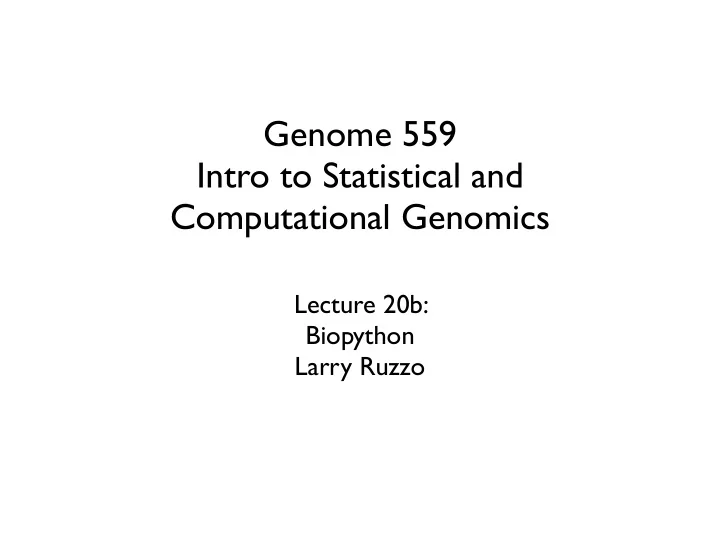

Genome 559 Intro to Statistical and Computational Genomics Lecture 20b: Biopython Larry Ruzzo
Biopython and Blast Can run Blast Either locally or over net Save results Parse and analyze results A sample problem: How good is Blast at finding tRNAs in Mj?
Exercise from Bio.Blast import NCBIWWW from Bio.Blast import NCBIXML import os if(not os.path.exists("trnablast.xml")): � query = "GGGGCCGTGGGGTAGCCTGGATATCCTGTGCGC...CCA" � eq = "Methanocaldococcus jannaschii[Organism]" � res_handle = NCBIWWW.qblast( "blastn", "nr", query, entrez_query = eq) � svfl = open("trnablast.xml", "w") � svfl.write(res_handle.read()) � svfl.close() � res_handle.close() resultHandle = open("trnablast.xml", "r") blastRecord = NCBIXML.read(resultHandle) print blastRecord.alignments[0].hsps[0] # Find data: score, Evalue, align len, start coord
How would I use Biopython? Biopython is not a program itself; it's a collection of tools for Python bioinformatics programing When doing bioinformatics, keep Biopython in mind Browse the documentation;become familiar with its capabilities Use help(), type(), dir() & other built-in features to explore You might prefer it to writing your own code for: - Defining and handling sequences and alignments - Parsing database formats - Interfacing with databases You don't have to use it all! Pick out one or two elements to learn first
Code re-use If someone has written solid code that does what you need, use it Don't "re-invent the wheel" unless you're doing it as a learning project Python excels as a "glue language" which can stick together other peoples' programs, functions, classes, etc.
Python – What next? Read scour the python/biopython web sites look at other people’s programs look at bits in the standard libraries (yes, some will be over your head, but it gets better...) use google Write programming takes practice - keep it up. small project in your lab? automated workflow? display your data on a pretty web page? redo early HW using tools learned later? keep statistics for your soccer team?
Other tools? these are more complex, but might pay off Again, wikipedia is often a good starting place, to get a general idea of what it is/whether it might be useful to you HTML plistlib & XML SQL and data bases “User Interfaces” e.g., tkinter
Bioinformatics - What next? work more of the Biopython tutorial focus on stuff you might use in the lab, to start next journal club, don’t just skim the methods even follow up with referenced papers wikipedia or other books: “Python for Bioinformatics” text books. Durbin Eddy Mitchison & Krogh especially recommended for the probabilistic modeling aspect. Ewans & Grant (we’ll add a few refs to the web) send me an email if you find something you like!
Recommend
More recommend